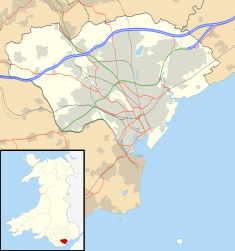Glamorgan Building
| Glamorgan Building | |
|---|---|
 Glamorgan Building | |
| Location | Cardiff |
| Coordinates | 51°29′09″N 3°10′53″W / 51.4859°N 3.1815°W |
| Built | 1912 |
| Architect | E. Vincent Harris Thomas A. Moodie |
| Architectural style(s) | Beaux-Arts classical style |
Listed Building – Grade I | |
| Designated | 25 January 1966 |
| Reference no. | 13738 |
The Glamorgan Building (Welsh: Adeilad Morgannwg) is a former county hall located at King Edward VII Avenue in Cathays Park, Cardiff, Wales. It was the headquarters of Glamorgan County Council from 1912 to 1974 and then of Mid Glamorgan County Council from 1974 to 1996. The building, which was acquired by Cardiff University in 1997 and is now home to the university's School of Social Sciences and the School of Geography and Planning, is a Grade I listed building.[1]
History
Design and construction
Following the implementation of the Local Government Act 1888, which established county councils in every county, it became necessary to find a meeting place for Glamorgan County Council.[2] Initially the county council used offices in Westgate Street and St Mary Street.[3] After finding this arrangement inadequate, county leaders decided to procure a purpose-built facility: the site they selected at Cathays Park was acquired from the Marquess of Bute in 1898.[1]
Construction of the new building started in 1909.[4] It was designed by Vincent Harris and Thomas Anderson Moodie in the Beaux-Arts classical style following a design competition[5] and was built by Turner & Sons of Cardiff at a cost of £67,724.[6] It was officially opened by the Chairman of the County Council, J. Blandy Jenkins,[7] as Glamorgan County Hall on 19 September 1912.[8] The design involved a symmetrical main frontage of seven bays facing King Edward VII Avenue; the central section of five bays featured a large portico with a deeply recessed entrance flanked by a series of pared Corinthian order columns.[1] Internally, the principal room was the council chamber.[1]
Serving as reminders of Glamorgan's source of wealth, two groups of statues by Albert Hodge, one representing navigation and the other coal mining, were unveiled outside the building.[9]
With the Local Government Act 1929, which transferred more powers to local authorities, a large extension was required. It was built to the south west of the main building to a design by Ivor Jones and Percy Thomas at a cost of £54,054[6] and opened on 22 September 1932.[6]
Recent history
Following the implementation of the Local Government Act 1972, which broke up Glamorgan County Council and established Mid Glamorgan County Council, the new county council took over the building.[2]
On 1 April 1996, under the Local Government (Wales) Act 1994, Mid Glamorgan County Council was abolished and the building was acquired by Cardiff University in 1997 and became home to the university's School of Social Sciences and the School of Geography and Planning.[10] The Glamorgan Record Office, which had been based in the building since 1939, relocated to a purpose-built office in Leckwith next to the Cardiff City football stadium as Glamorgan Archives in 2009.[11]
References
- ^ a b c d Cadw. "Glamorgan Building (13738)". National Historic Assets of Wales. Retrieved 15 April 2020.
- ^ a b "Glamorgan County Council". Archives Hub. Archived from the original on 21 October 2019. Retrieved 21 October 2019.
- ^ "Glamorgan County Hall". Cardiff Parks. Retrieved 31 October 2020.
- ^ Hilling, John B. (2016). The History and Architecture of Cardiff Civic Centre: Black Gold, White City. University of Wales. ISBN 978-1783168422.
- ^ "Thomas Anderson Moodie". Dictionary of Scottish Architects. Retrieved 31 October 2020.
- ^ a b c Chappell, Edgar L. (1946). Cardiff's Civic Centre: A historical guide. Priory Press. p. 41.
- ^ "Glamorgan County Council. The Election of Chairman". South Wales Echo. 14 March 1895. p. 2. Retrieved 17 May 2019.
- ^ William Rees (1969), "The Reformed Borough, 1836-1914", Cardiff - A History Of The City, The Corporation of the City of Cardiff, p. 338
- ^ "Albert H. Hodge (1875–1918)". Bob Speel. Retrieved 31 October 2020.
- ^ "These are all the grade one listed buildings in Cardiff". Wales Online. 10 December 2018. Retrieved 21 October 2019.
- ^ "All Black souvenir comes to light". BBC News. 5 November 2009. Retrieved 18 December 2015.





